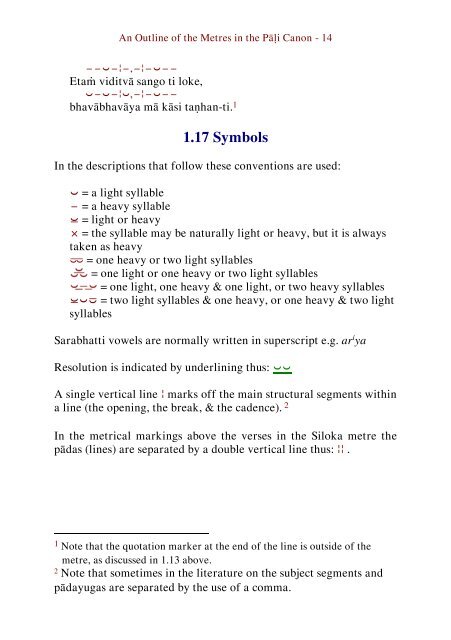An Outline of the Metres in the Pāḷi Canon
A concise but thorough explanation of the metres that are found in the Pāli canon, along with examples and glossary.
A concise but thorough explanation of the metres that are found in the Pāli canon, along with examples and glossary.
Create successful ePaper yourself
Turn your PDF publications into a flip-book with our unique Google optimized e-Paper software.
<strong>An</strong> <strong>Outl<strong>in</strong>e</strong> <strong>of</strong> <strong>the</strong> <strong>Metres</strong> <strong>in</strong> <strong>the</strong> <strong>Pāḷi</strong> <strong>Canon</strong> - 14<br />
−−⏑−¦−,−¦−⏑−−<br />
Etaṁ viditvā sango ti loke,<br />
⏑−⏑−¦⏑,−¦−⏑−−<br />
bhavābhavāya mā kāsi taṇhan-ti. 1<br />
1.17 Symbols<br />
In <strong>the</strong> descriptions that follow <strong>the</strong>se conventions are used:<br />
⏑ = a light syllable<br />
− = a heavy syllable<br />
⏓ = light or heavy<br />
× = <strong>the</strong> syllable may be naturally light or heavy, but it is always<br />
taken as heavy<br />
⏔ = one heavy or two light syllables<br />
= one light or one heavy or two light syllables<br />
= one light, one heavy & one light, or two heavy syllables<br />
⏓⏑⏒ = two light syllables & one heavy, or one heavy & two light<br />
syllables<br />
Sarabhatti vowels are normally written <strong>in</strong> superscript e.g. ar i ya<br />
Resolution is <strong>in</strong>dicated by underl<strong>in</strong><strong>in</strong>g thus: ⏑⏑<br />
A s<strong>in</strong>gle vertical l<strong>in</strong>e ¦ marks <strong>of</strong>f <strong>the</strong> ma<strong>in</strong> structural segments with<strong>in</strong><br />
a l<strong>in</strong>e (<strong>the</strong> open<strong>in</strong>g, <strong>the</strong> break, & <strong>the</strong> cadence). 2<br />
In <strong>the</strong> metrical mark<strong>in</strong>gs above <strong>the</strong> verses <strong>in</strong> <strong>the</strong> Siloka metre <strong>the</strong><br />
pādas (l<strong>in</strong>es) are separated by a double vertical l<strong>in</strong>e thus: ¦¦ .<br />
1 Note that <strong>the</strong> quotation marker at <strong>the</strong> end <strong>of</strong> <strong>the</strong> l<strong>in</strong>e is outside <strong>of</strong> <strong>the</strong><br />
metre, as discussed <strong>in</strong> 1.13 above.<br />
2<br />
Note that sometimes <strong>in</strong> <strong>the</strong> literature on <strong>the</strong> subject segments and<br />
pādayugas are separated by <strong>the</strong> use <strong>of</strong> a comma.

















